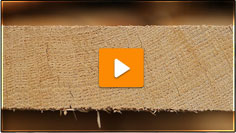Cherry
The heartwood of cherry varies from rich red to reddish-brown that darkens with age and exposure to light. The sapwood of cherry is a creamy white.
Cherry has a uniform, straight-grained, satiny, smooth texture and may naturally contain brown pith flecks and small gum pockets. It has a medium density with good bending properties, low stiffness, and a medium strength and shock resistance.
This hardwood can be used for flooring, moulding, millwork, furniture, cabinetry, paneling, doors, boat interiors, musical instruments, turnings and carvings.
Availability by Thickness
| Thickness |
Grades |
Widths |
| |
FAS |
#1 Com |
#2 Com |
Rift & Qrtd |
Random Widths |
Rip to Width |
| 4/4 |
 |
 |
 |
|
 |
 |
| 5/4 |
 |
|
|
|
 |
|
| 6/4 |
 |
|
|
|
 |
|
| 8/4 |
 |
|
|
|
 |
|
| 10/4 |
|
|
|
|
|
|
| 12/4 |
|
|
|
|
|
|
| 16/4 |
|
|
|
|
|
|
Cypress
The sapwood of cypress is pale yellow-white with the heartwood varying in color from light to dark or reddish-brown.
Although it is a soft wood, cypress grows alongside—and is traditionally grouped and manufactured with—hardwoods. The oils in its heartwood make it one of the most durable woods when exposed to moisture conditions causing decay.
Cypress can be used in flooring, moulding, millwork, siding, shutters, shingles, trim, fence posts, paneling, cabinetry and furniture.
Availability by Thickness
| Thickness |
Grades |
Widths |
| |
FAS |
#1 Com |
#2 Com |
Rift & Qrtd |
Random Widths |
Rip to Width |
| 4/4 |
 |
 |
 |
|
 |
 |
| 5/4 |
 |
|
|
|
 |
 |
| 6/4 |
 |
|
|
|
 |
|
| 8/4 |
 |
|
|
|
 |
|
| 10/4 |
|
|
|
|
|
|
| 12/4 |
|
|
|
|
|
|
| 16/4 |
|
|
|
|
|
|
Hickory
Hickory is the hardest, heaviest and strongest American wood. The sapwood is white, tinged with inconspicuous fine brown lines, while the heartwood is pale to reddish-brown.
This hardwood has a coarse texture and fine grain that is usually straight but can be wavy or irregular. Hickory is also well known for very good strength, shock resistance and its excellent steam-bending properties.
Hickory is used for flooring, tool handles, furniture, cabinetry, paneling, wooden ladders, dowels and sporting goods.
Availability by Thickness
| Thickness |
Grades |
Widths |
| |
FAS |
#1 Com |
#2 Com |
Rift & Qrtd |
Random Widths |
Rip to Width |
| 4/4 |
 |
 |
 |
|
 |
 |
| 5/4 |
 |
|
|
|
 |
|
| 6/4 |
 |
|
|
|
 |
|
| 8/4 |
|
|
|
|
|
|
| 10/4 |
|
|
|
|
|
|
| 12/4 |
|
|
|
|
|
|
| 16/4 |
|
|
|
|
|
|
Hard Maple
The sapwood of hard maple is creamy white with a slight reddish-brown tinge. The heartwood varies from light to dark reddish-brown.
Hard maple has a close, fine, uniform texture and is generally straight-grained, but it can also occur as curly, fiddleback or bird’s-eye figured.
This hardwood can be used for flooring, furniture, millwork, paneling, kitchen cabinets, worktops, tabletops, butcher blocks, toys, kitchenware, and ballroom and gymnasium floors.
Availability by Thickness
| Thickness |
Grades |
Widths |
| |
FAS |
#1 Com |
#2 Com |
Rift & Qrtd |
Random Widths |
Rip to Width |
| 4/4 |
 |
 |
 |
|
 |
 |
| 5/4 |
 |
|
|
|
 |
|
| 6/4 |
 |
|
|
|
 |
|
| 8/4 |
 |
|
|
|
 |
|
| 10/4 |
 |
|
|
|
 |
|
| 12/4 |
|
|
|
|
|
|
| 16/4 |
|
|
|
|
|
|
Poplar
Poplar’s sapwood is creamy white and may be streaked. Its heartwood can vary from pale yellowish-brown to olive green. The green color in the heartwood tends to darken on exposure to light and turn brown.
This hardwood has a medium to fine texture and is straight-grained. Its medium density allows low bending, shock resistance, stiffness and compression values. It has a medium steam-bending classification with excellent strength and stability.
Poplar can be used in moulding, millwork, light construction, furniture, kitchen cabinets, doors, musical instruments, exterior trim, siding, paneling, edge-glued panels, turnings and carvings.
Availability by Thickness
| Thickness |
Grades |
Widths |
| |
FAS |
#1 Com |
#2 Com |
Rift & Qrtd |
Random Widths |
Rip to Width |
| 4/4 |
 |
 |
 |
|
 |
 |
| 5/4 |
 |
 |
|
|
 |
 |
| 6/4 |
 |
 |
|
|
 |
|
| 8/4 |
 |
 |
|
|
 |
 |
| 10/4 |
 |
|
|
|
 |
|
| 12/4 |
 |
|
|
|
 |
|
| 16/4 |
 |
|
|
|
 |
|
White Oak
With light-colored sapwood and light to dark brown heartwood, white oak is mostly straight-grained with a medium to coarse texture.
It is a hard and heavy wood with medium bending and crushing strength and a natural durability that makes it resistant to decay.
White oak can be used in flooring, moulding, construction, furniture, joinery, doors, cabinets, paneling, railway sleepers, timber bridges, barrel staves and coffins.
Availability by Thickness
| Thickness |
Grades |
Widths |
| |
FAS |
#1 Com |
#2 Com |
Rift & Qrtd |
Random Widths |
Rip to Width |
| 4/4 |
 |
 |
 |
 |
 |
 |
| 5/4 |
 |
 |
 |
|
 |
 |
| 6/4 |
 |
 |
 |
|
 |
 |
| 8/4 |
 |
 |
 |
|
 |
 |
| 10/4 |
 |
 |
|
|
 |
|
| 12/4 |
|
|
|
|
|
|
| 16/4 |
|
|
|
|
|
|
Yellow Birch
Yellow birch has a white sapwood and light reddish-brown heartwood. It is generally straight-grained with a fine uniform texture and characterized by a plain and often wavy pattern.
This hardwood is heavy and strong with good bending properties, good crushing strength and shock resistance.
Yellow birch is used in flooring, millwork and paneling, furniture, kitchen cabinets, doors, turning, and toys.
Availability by Thickness
| Thickness |
Grades |
Widths |
| |
FAS |
#1 Com |
#2 Com |
Rift & Qrtd |
Random Widths |
Rip to Width |
| 4/4 |
 |
|
|
|
 |
|
| 5/4 |
|
|
|
|
|
|
| 6/4 |
|
|
|
|
|
|
| 8/4 |
|
|
|
|
|
|
| 10/4 |
|
|
|
|
|
|
| 12/4 |
|
|
|
|
|
|
| 16/4 |
|
|
|
|
|
|


























